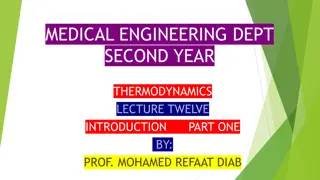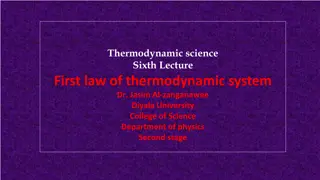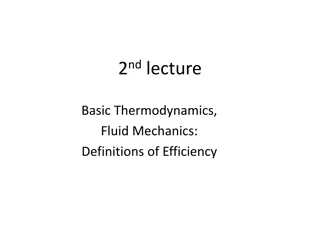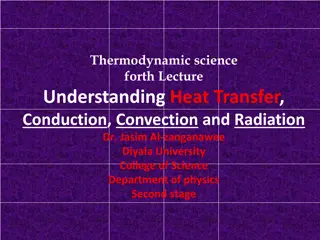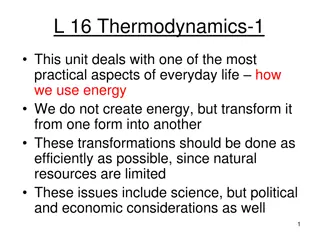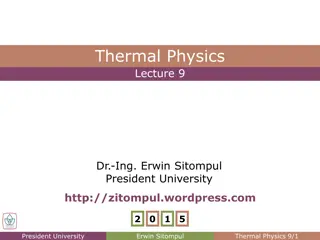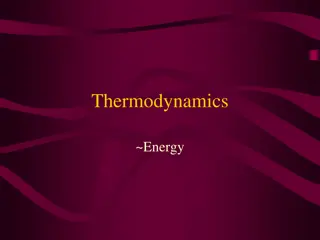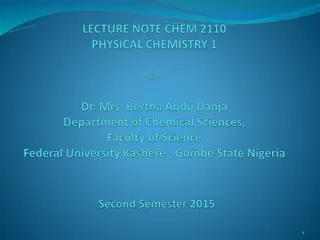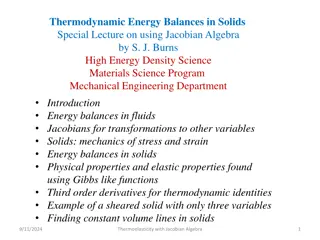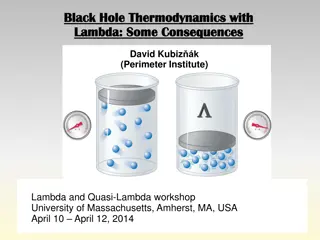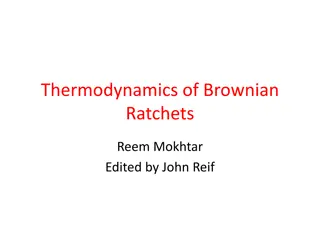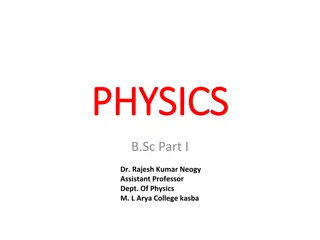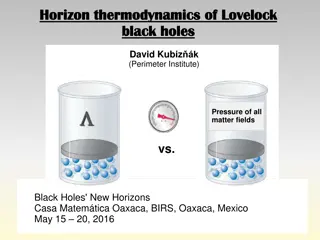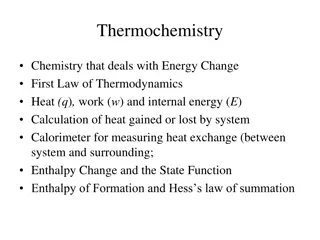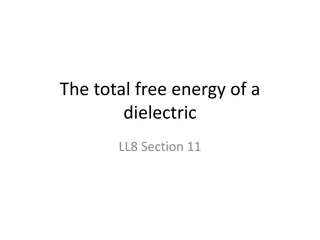Understanding Basics of Thermodynamics and Energy Principles
Explores fundamental concepts in thermodynamics, including energy, the first law of thermodynamics, heat vs. temperature, system vs. surroundings, direction of heat flow, thermal equilibrium, exothermic vs. endothermic processes, and units of energy. Learn about energy conversions, conservation, and heat transfer in various systems.
Download Presentation

Please find below an Image/Link to download the presentation.
The content on the website is provided AS IS for your information and personal use only. It may not be sold, licensed, or shared on other websites without obtaining consent from the author. Download presentation by click this link. If you encounter any issues during the download, it is possible that the publisher has removed the file from their server.
E N D
Presentation Transcript
Thermodynamics X Unit 9
Energy: Basic Principles Thermodynamics the study of energy changes Energy the ability to do work or produce heat Kinetic Energy energy of motion Potential Energy energy due to position or composition
Law of Conservation of Energy A.k.a. First Law of Thermodynamics Energy can be converted from one form to another but can t be created or destroyed This means the total energy of the universe is CONSTANT!
Heat vs. Temperature Temperature measure of the random motion of a substance Temperature is proportional to kinetic energy (it is a measure of the average kinetic energy in a substance) Heat (q) flow of energy due to a temperature difference
System vs. Surroundings A system is the part of the universe we are studying. The surroundings are everything else outside of the system.
Direction of Heat Flow Heat transfer occurs when two objects are at two different temperatures. Eventually the two objects reach the same temperature At this point, we say that the system has reached equilibrium.
Thermal Equilibrium Heat transfer always occurs with heat flowing from the HOT object to the COLD object.
Exothermic vs. Endothermic Exothermic process heat is transferred from the system to the surroundings Heat is lost from the system (temperature in system decreases) Endothermic process heat transferred from the surroundings to the system Heat is added to the system (temperature in system increases)
Units of Energy Joule (J) is the SI unit of energy & heat One kilojoule (kJ) = 1000 joules (J) calorie (cal) = heat required to raise the temperature of 1.00 g of water by 1 C 1 calorie = 4.184 J
Units of Energy Food is measured in Calories (also known as kilocalories) instead of calories 1 Cal = 1 kcal = 1000 calories
Units of Energy 3800 cal = __________ Cal = _________ J
Units of Energy The label on a cereal box indicates that 1 serving provides 250 Cal. What is the energy in kJ?
Heat Transfer Direction and sign of heat flow MEMORIZE! ENDOTHERMIC: heat is added to the system & the temperature increases (+q) EXOTHERMIC: heat is lost from the system (added to the surroundings) & the temperature in the system decreases (-q)
Specific Heat (Specific Heat Capacity) Specific Heat (C) - The quantity of heat required to raise the temperature of one gram of a substance by 1 C Units: J/(g C) or J/(g K) cal/(g C) or cal/(g K)
Examples of Specific Heat At the beach, which gets hotter, the sand or the water? Higher specific heat means the substance takes longer to heat up & cool down!
Examples of Specific Heat Specific heat (C)= the heat required to raise the temperature of 1 gram of a substance by 1 C Cwater= 4.184 J/(g C) Csand= 0.664 J/(g C)
Calculating Changes in Thermal E q = mC T q = heat (J) m = mass (g) C = specific heat capacity, J/(g C) T = change in temperature, Tfinal Tinitial ( C or K) ***All units must match up!!!***
q = mCt Example How much heat in J is given off by a 75.0 g sample of pure aluminum when it cools from 84.0 C to 46.7 C? The specific heat of aluminum is 0.899 J/(g C).
q = mCt Example What is the specific heat of benzene if 3450 J of heat are added to a 150.0 g sample of benzene and its temperature increases from 22.5 C to 35.8 C?
Enthalpy Enthalpy (H) The heat content of a reaction (chemical energy) H = change in enthalpy The amount of energy absorbed or lost by a system during a chemical process H = Hfinal - Hinitial
Two Ways to Designate Thermochemical Equations Endothermic: a)H2 (g) + I2 (s) 2 HI (g) H = 53.0 kJ b)H2 (g) + I2 (s) + 53.0 kJ 2 HI (g)
Two Ways to Designate Thermochemical Equations Exothermic: a) CH4 (g) + O2 (g) CO2 (g) + H2O (l) H = -445.2 kJ b) CH4(g) + O2(g) CO2(g) + H2O(l) + 445 .2 kJ
Two Ways to Designate Thermochemical Equations Note the meaning of the sign in H in the equations above!! Endothermic: H = + Exothermic: H = -



